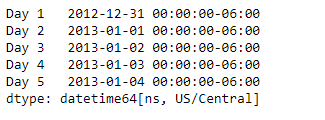Python| Pandas Series.dt.to_pydatetime
Series.dt可用于以 datetimelike 的形式访问系列的值并返回多个属性。 Pandas Series.dt.to_pydatetime()函数将数据作为原生Python日期时间对象的数组返回。如果存在时区信息,则保留。
Syntax: Series.dt.to_pydatetime()
Parameter : None
Returns : numpy.ndarray
示例 #1:使用Series.dt.to_pydatetime()函数将给定的系列对象作为原生Python日期时间对象的数组返回。
# importing pandas as pd
import pandas as pd
# Creating the Series
sr = pd.Series(['2012-12-31', '2019-1-1 12:30', '2008-02-2 10:30',
'2010-1-1 09:25', '2019-12-31 00:00'])
# Creating the index
idx = ['Day 1', 'Day 2', 'Day 3', 'Day 4', 'Day 5']
# set the index
sr.index = idx
# Convert the underlying data to datetime
sr = pd.to_datetime(sr)
# Print the series
print(sr)
输出 :

现在我们将使用Series.dt.to_pydatetime()函数将数据作为原生Python日期时间对象的数组返回。
# return the series data as a
# native python datetime data
result = sr.dt.to_pydatetime()
# print the result
print(result)
输出 :

正如我们在输出中看到的, Series.dt.to_pydatetime()函数已成功将给定系列对象的基础数据作为原生Python日期时间数据数组返回。
示例 #2:使用Series.dt.to_pydatetime()函数将给定的系列对象作为原生Python日期时间对象的数组返回。
# importing pandas as pd
import pandas as pd
# Creating the Series
sr = pd.Series(pd.date_range('2012-12-31 00:00', periods = 5, freq = 'D',
tz = 'US / Central'))
# Creating the index
idx = ['Day 1', 'Day 2', 'Day 3', 'Day 4', 'Day 5']
# set the index
sr.index = idx
# Print the series
print(sr)
输出 :

现在我们将使用Series.dt.to_pydatetime()函数将数据作为原生Python日期时间对象的数组返回。
# return the series data as a
# native python datetime data
result = sr.dt.to_pydatetime()
# print the result
print(result)
输出 :

正如我们在输出中看到的, Series.dt.to_pydatetime()函数已成功将给定系列对象的基础数据作为原生Python日期时间数据数组返回。